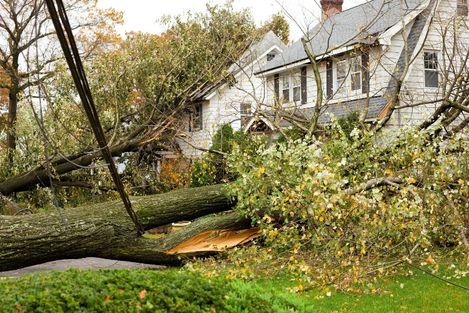
Written by Kayla Jane Barrie Updated on Feb 21, 2025 6 mins read

Do you need to file a home insurance claim? The thought of a basement flood, fire, or a tree falling on your roof is not something homeowners want to think about. But the reality is, it happens, and you need to be prepared.
According to data from 2023 FACTS of the Property and Casualty Insurance Industry in Canada, private P&C insurers wrote $17.4 billion in direct written premiums for personal property insurance and paid out $9.9 billion for direct claims incurred (2022). This is $2 billion more than IBC reported in 2019 when insurers paid out $7.9 billion related to personal property. With these numbers on the rise, having proper coverage helps protect your investment and minimize these risks.
Weather damage, accidents, thefts, and property damage happen. Opening a claim will affect your insurance record, and it can increase your premiums. Knowing how and when to file is crucial information to understand. Here’s what the process looks like:
Whether or not you should file depends on many factors. Here’s a list of top things to consider when making a decision to start a claim:
In most instances, paying for small damage out of pocket makes more sense and is less hassle, especially if you have the money to cover the repairs. Consider all costs before filing - even small ones can have an impact. Speak with our brokers if you are not sure what to do.
Your home insurance premiums are pooled and used by insurers to payout claims. When you file a claim, funds are taken from the pooled money to cover your payout. You are responsible for paying the deductible amount, and your insurer will pay the remainder of the costs for included perils, up to your policy limit.
Always think twice before opening an insurance claim. Remember that each claim added to your insurance record could increase premiums. Claims will stay on your record for multiple years, and your rates will remain elevated during this time. Here’s an example of how the number of home insurance claims can affect your payments:
| Number of claims | Avg annual premium (2024-25) | Monthly payment | Premium increase (%) |
|---|---|---|---|
| No claims | $1,411 | $118 | |
| 1 claim | $1,517 | $126 | 7.50% |
| 2 claims | $1,564 | $130 | 10.80% |
Based on our customer quote data*, a single home insurance claim can increase your premiums by 7.5%. Two claims can increase your rates by over 10%. More serious and larger dollar-value claims could increase your rates even more.
There are 5 common types of claims insurers see most frequently:
Filing is a fairly standard process. Most companies follow very similar steps as outlined here:
Filing a claim does not automatically mean it will be accepted. There are many reasons it can be denied, including:
A claim can also be rejected if you lie to your insurer on your application or if you are late on payments.
Use these tips to simplify the process:
Yes. Most insurers have a time limit on when you must open it. The limit can vary from as little as three months up to one year from the damage or loss date. Check with your insurer to clarify the time frame.
Most insurers provide you with one year to open and finalize it. If you do not finalize it after one year, it could be denied. Speak with your insurer about the process and time limits.
There are ways to resolve the situation. Here is what to do if it is denied:
You may be cancelled upon renewal after a significant amount. It’s unlikely it would be cancelled immediately unless they believe you engaged in fraudulent activities.
You could see an increase in premiums after filing a claim. However, it should not affect your renewal if you have a clean record and have not filed within the last five years. However, this can vary depending on your insurance provider.
Claims typically stay on your record for 5 to 7 years and may increase your payments during this time. Even if you switch providers, your record will follow you.
While you are supposed to use the money to make repairs and replace damaged items, you are free to use it as you wish. However, it is advisable to use the money for its intended purposes – to restore your home to its state prior to a loss.
How you receive the settlement depends on your preferences, situation and how your insurer processes them. Some people choose to take funds and pay contractors directly. Others choose to have the insurers pay contractors directly for repairs.
While there is no set number, the fewer, the better. In most cases, one every 5 years is an acceptable amount. Too many could result in your policy not getting renewed. Many insurers will not renew home insurance with a history of claims. Speak with an advisor if you are having issues getting insured.
False claims and insurance fraud are leading factors for rising costs. It could be denied if you are caught providing deceptive information or purposely misleading insurers, and your policy will be cancelled. Exaggerating or inflating the extent of a situation is a crime. Your insurer could also press charges against you.
Some people may have difficulty changing providers after. Having a fresh claim on your record is not the best time to shop around. Working with an advisor is your best option to explore your options.
Contact us if you have questions about the claims process. See our claims services page for 24/7 Emergency Claims Numbers for our insurance partners.
Source
*Home insurance property and premium collected from Ontario ThinkInsure customers from January 1, 2024, to January 1, 2025.
| Categories | Home |
|---|---|
| Tags | Home CoverageHomeowners Claims |
Read our insurance blog to get helpful tips, information and news.
Impaired driving in Ontario is a serious offence. Learn about impaired driving fines, penalties, statistics and other important information all drivers in Ontario need to be aware of before they get behind the wheel.
Learn why parking violations are non-moving, how long they stay on your record, and the serious indirect risk of unpaid tickets.
Has your car been totalled in an accident? Is your car a write off? Learn about vehicle write offs for a total loss insurance claim.
Get the facts on Toronto's auto theft problem. We break down the data, reveal the most-stolen vehicles (including the Honda CR-V and Lexus RX 350), and show which neighbourhoods are most affected.